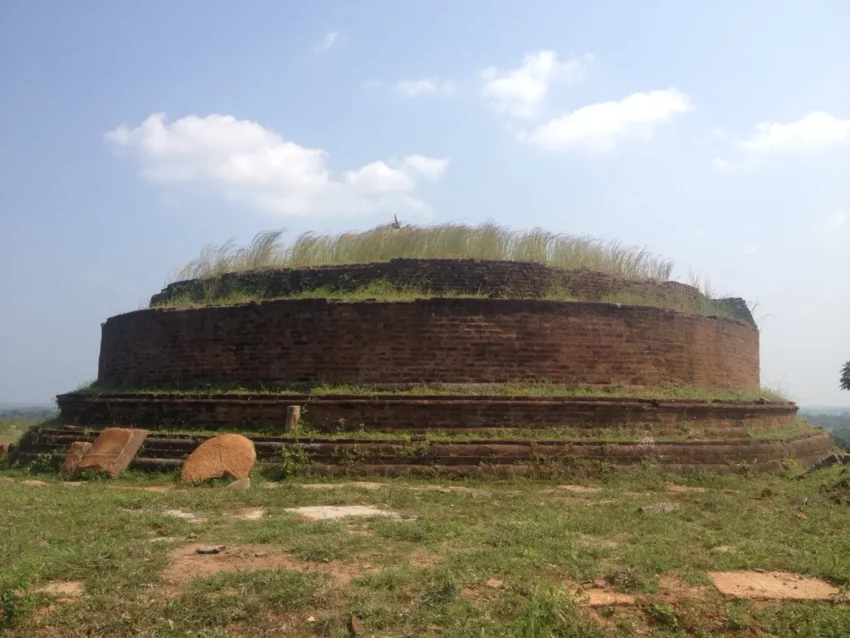Get your dose of History via Email
An Examination of Lahugala Kota Vehera
The site of Lahugala Kota Vehera, situated within the realm of Lahugala Kitulana National Park on the island nation of Sri Lanka, holds pertinence as an ancient Buddhist stupa. The etymological origins of this edifice’s name can be deciphered as “stupa with the fortress” or “stupa within the fort”, a terminology that suggests the existence of a defensive structure in proximity to the religious monument. The geographical coordinates place Lahugala Kota Vehera amidst the Eastern Province of Sri Lanka, within the historic and once flourishing Ruhuna Kingdom.
The tectonic narrative of Lahugala Kota Vehera commences in the prehistoric times, with its inception attributed to King Mahanaga in the 2nd century BC, during a period characterized by a burgeoning fervor for the construction of Buddhist religious structures. The stupa’s affiliation with King Mahanaga, a historical figure who bore the mantle of authority in Ruhuna, is derived from the Mahavamsa, an authoritative and chronologically organized chronicle of Sri Lankan history.
Archaeologically speaking, Lahugala Kota Vehera asserts itself not merely as a solitary monument but as a component of a larger monastic complex. The site is distinguished by the colossal dimensions of the stupa, which stands at a height of 12 meters and encompasses a diameter of 40 meters. A circumambulating path, an integral element in the physical make-up of stupas, envelops the main structure and is ensconced by a precisely arranged balustrade. By virtue of its sizeable physical proportions, Lahugala Kota Vehera is recognized as one of the largest stupas situated in the eastern region of Sri Lanka.
The stupa’s significance is not solely attributed to its mere existence and structural properties, but also to the cultural artifacts excavated from the surrounding area. The central figure among these is a stone inscription, time-stamped to the 2nd century BC, which has provided credence to the assertions that connect the stupa to King Mahanaga. Further, the haste with which the site was abandoned signals the probable occurrence of a major calamity, such as an invasion or natural disaster, events that could offer an explanation to the absence of human settlement traces after the 2nd century.
Preservation and Conservation
In the contemporary context, the Lahugala Kota Vehera persists as a subject of archeological interest and religious reverence. The site has been subjected to restoration endeavors led by the Department of Archaeology of Sri Lanka. These restoration actions not only face the challenge of reinforcing the stupa’s stability but also involve the resolute task of preserving the historical integrity of the structure and its surrounding region.
The conservation efforts are necessitated by the decaying effects of incessant weathering processes and the perpetual threat of vegetation overgrowth, the latter being a circumstance imposed by the stupa’s position within a national park that teems with wildlife and rich flora. Herein, the goal of the conservation efforts is to navigate the delicate balance between preserving the natural habitat and the man-made cultural heritage that the Lahugala Kota Vehera embodies.
Relevance of Lahugala Kota Vehera in Buddhist Cultural Heritage
The enduring relevance of Lahugala Kota Vehera is anchored in its role as a testament to the formative years of Buddhism in Sri Lanka. The stupa’s establishment within the earliest phases of the religion’s substantive appearance on the island underpins its pivotal position within the tapestry of Sri Lankan Buddhist heritage. The period which bore witness to the creation of Lahugala Kota Vehera was marked by the proliferation of Buddhism under royal patronage, with stupas crystallizing as focal points of Buddhist monastic complexes and social life. Consequently, Lahugala Kota Vehera is emblematic of both the religious and socio-cultural metamorphosis during an epoch that was seminal in shaping the religious contours of Sri Lanka.
Further amplifying its prestige is the stupa’s status as one of the veritably ancient monuments that illumine the antiquated timeline of Buddhist monastic architecture in the Eastern Province, offering a lens through which the scholarly community can perceive early Buddhist architectural traditions and urban planning.
Conclusively, Lahugala Kota Vehera stands out as a site worthy of scholarly exploration and religious esteem. It is embedded with a multiplicity of narratives that manage to inform us about the complex interactions between architecture, religion, and the forces of nature; it preserves the footprints left by a civilization that thrived over two millennia ago.

